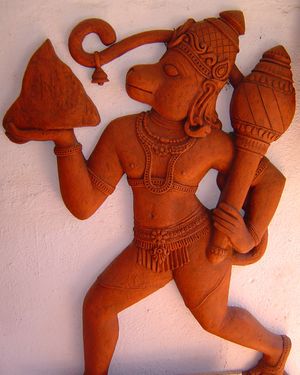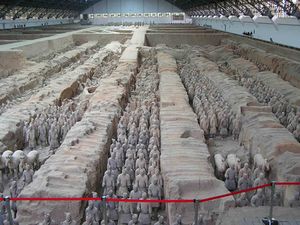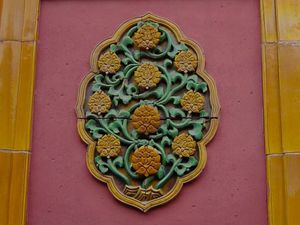طين نضيج


الطين النضيج، تراكوتا أو ترا-كوتا [1]، نوع من الخزف، وهو مكون من سيراميك الطين المطلي أو الغير مطلي،[2] where the fired body is porous.[3][4][5][6] يستخدم في صنع الأواني (وأشهرها أصيص الزهور) أنابيب المياه والصرف، الطوب، وزخرفة الأسطح في انشاءات المباني، وكذلك في أعمال النحت مثل جيش تراكوتا، وتماثيل تراكوتا اليونانية. يستخدم المصطلح أيضاً للإشارة إلى هذه المادة وطبيعتها، اللون البرتقالي المائل للبني، والذي يتميز بدرجاته المتفاوتة. في علم الآثار وتاريخ الفن، يستخدم مصطلح "تراكوتا" عادة للإشارة للأشياء التي تصنع على عجلة الفخار، مثل التماثيل، حيث تصنع على عجلة من نفس المادة، وربما يكون بواسطة نفس الشخص، الذي يطلق عليه صانع الفخار؛ اختيار المصطلح يعتمد على نوع الاشيء أكثر منه على المادة[بحاجة لمصدر].
الانتاج والخصائص
التاريخ
في تاريخ الفن
في الكيماء
مميزاته في النحت
Relief from Buddhist Monument. The Walters Art Museum.
Rare terracotta image of Isis lamenting the loss of Osiris (Eighteenth Dynasty, Egypt) Musée du Louvre, Paris
The Etruscan "Sarcophagus of the Spouses", at the National Etruscan Museum.
The Bell Edison Telephone Building, Birmingham, England.
The Natural History Museum in London has an ornate terracotta façade typical of high Victorian architecture. The carvings represent the contents of the Museum.
اللون
الطين النضيج
| الترا كوتا | |
|---|---|
| Hex triplet | #E2725B |
| sRGBB (r, g, b) | (226, 114, 91) |
| HSV (h, s, v) | (10°, 60%, 89%) |
| CIELChuv (L, C, h) | (61, 90, 20°) |
| المصدر | DMC Color List |
| B: Normalized to [0–255] (byte) | |
الطين النضيج الداكن
| التراكوتا الداكن | |
|---|---|
| Hex triplet | #CC4E5C |
| sRGBB (r, g, b) | (204, 78, 92) |
| HSV (h, s, v) | (353°, 62%, 80%) |
| CIELChuv (L, C, h) | (51, 92, 8°) |
| المصدر | Encycolor |
| B: Normalized to [0–255] (byte) | |
انظر أيضاً
- الطين النضيج الأثري
- Cittacotte
- Glazed architectural terracotta
- قائمة الألوان
- Majapahit Terracotta
- كولهار (كؤوس تقليدية من الطين النضيج)
المصادر
- ^ Merriam-Webster.com
- ^ OED, "Terracotta"
- ^ ‘Diagnosis Of Terra-Cotta Glaze Spalling.’ S.E. Thomasen, C.L. Searls. Masonry: Materials, Design, Construction and Maintenance. ASTM STP 992 Philadelphia, USA, 1988. American Society for Testing & Materials.
- ^ ‘Colour Degradation In A Terra Cotta Glaze’ H.J. Lee, W.M. Carty, J.Gill. Ceram.Eng.Sci.Proc. 21, No.2, 2000, p.45-58.
- ^ ‘High-lead glaze compositions and alterations: example of byzantine tiles.’ A. Bouquillon. C. Pouthas. Euro Ceramics V. Pt.2. Trans Tech Publications, Switzerland,1997, p.1487-1490 Quote: “A collection of architectural Byzantine tiles in glazed terra cotta is stored and exhibited in the Art Object department of the Louvre Museum as well as in the Musee de la Ceramique de Sevres.”
- ^ 'Industrial Ceramics.' F.Singer, S.S.Singer. Chapman & Hall. 1971. Quote: "The lighter pieces that are glazed may also be termed 'terracotta.'
وصلات خارجية
- Article on terracotta in Victorian and Edwardian Terracotta Buildings
- Bibliography, Smithsonian Institution, Ceramic Tiles and Architectural Terracotta
- Tile Heritage Foundation (US)
- Friends of Terra Cotta, non-profit foundation to promote education and preservation of architectural Terracotta
- Tiles and Architectural Ceramics Society (UK)
- La Terracotta (IT)
- Guidance on Matching Terracotta Practical guidance on the repair and replacement of historic terracotta focusing on the difficulties associated with trying to match new to old






